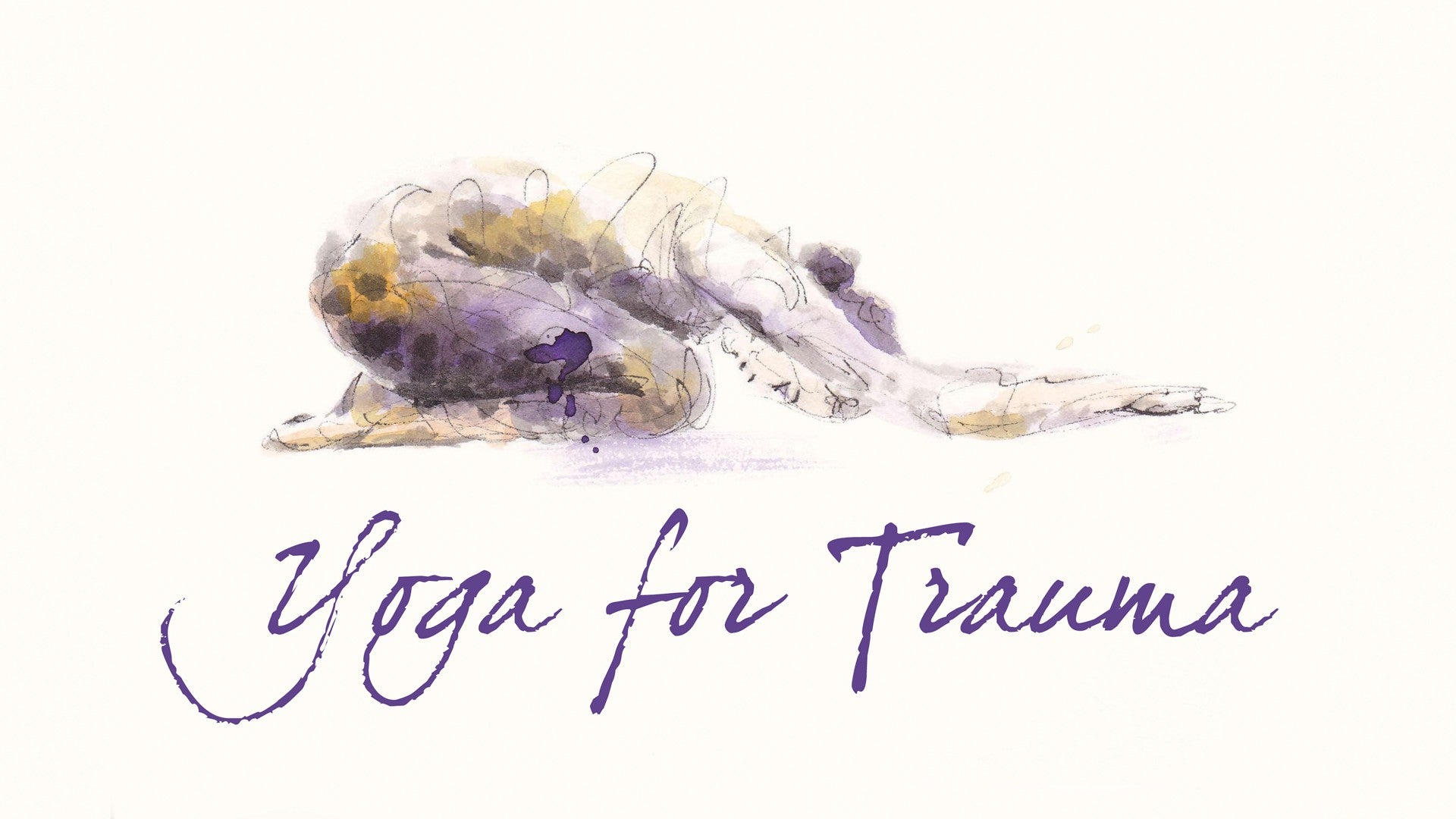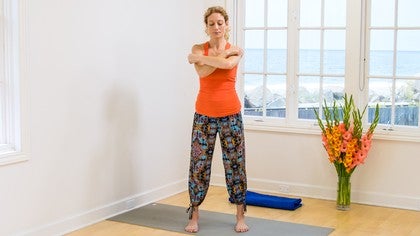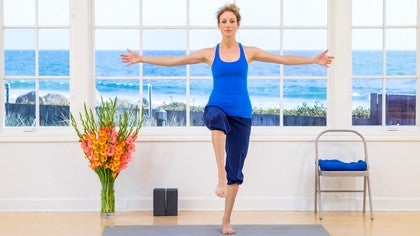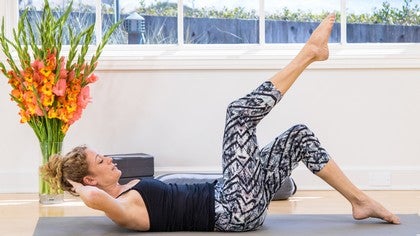Description
About This Video
Transcript
Read Full Transcript
(wave crashing) Welcome. This is a quick tools practice to work with stuck energy, and that might show up as numbness or frozen or even depression. So when there's an overwhelming experience our bodies mobilize without us even thinking. The body really prepares for the fight and flight response by pumping tons of adrenaline and cortisol into the system in order to get us out of harm's way. Now if we can't get out of harm's way we tend to freeze, and if that energy at some point isn't processed or discharged it just kinda gets stuck in the body.
I liken this to having too much electricity kinda of surging through a house. At some point if the current's too big it's gonna blow the fuses, and if it doesn't blow the fuses it's just gonna shut everything off, and that's how it can feel if we're holding that energy. We feel heavy, can't motivate, numb, just disconnected from feelings. It can often even move into just like a sense of low self esteem, of not feeling any worth, or even just having a hopelessness in like our perspective in the world. So this practice today is these tools.
It's gonna be some short ways to help connect into a little bit more energy and hopefully a smoother current. Now remember, especially if you're dealing with more kind of depression or kind of freeze feelings, less is more. Just a little bit can go a long way so if, you know, take a little bit, try a little bit, and then see how your body responds. Being able to feel yourself is really essential to being in relationship and to being in this world, but a lot of us don't actually feel like we're here. We feel like we're, you know, our bodies are here but our minds or our hearts are really someplace else.
One way to get into our own skin kind of in a safe way is to just, you know, remind ourselves that we have this physical boundary, so bring your hands to the opposite arms and nice and gently but also with a little bit of pressure, give yourself just some squeezes and notice the boundary of your skin. Uh huh. And go up and down the arms, and for some of you it's gonna be helpful to say these are my arms, especially if you get flooded and tend to be pulled out of your body, these are my arms, and then to your hands. And feel free to wring the hands until they start to feel real. It might not feel real right away and this might not feel truthful to say these are my hands.
Just try it a couple of times until it starts to become, you start to be more present with your actual physical experience. You can go down to the legs, bend the knees a little bit and rub the legs. These are my legs, these are my thighs. Down through the shins, these are my legs. And of course you can move to just about any part of your body, this is my belly.
So just that physical contact of self and the reminder of the words, bringing those two things together. Now another way of doing this and also bringing more circulation to your system, especially when it's kind of depressed, it's hard to move, we need circulation, we need the lymphatic system to help us kind of drain out and detoxify. Being able to move it just by tapping can bring a little bit of life back, so instead of the squeeze it's just really soft taps, right, up and down, and then you can take it to the outside edge of the hips and all the way down through the legs, and up through the thighs, and then outer legs down through shins. Do this a few times. You can move to the kidneys in the low back, right, but gentle.
You can go to the chest, and if it helps to say this is my chest, go ahead. If you start to tap the face, completely good, or the head, fingers, not fists (laughs), so fingers, light, and bring some circulation in. Notice if you can breath while you do this, and then pause and sense if there's any sort of buzzing or tingling, or just a sense of life. This next technique is orienting and I use it in pretty much all of the practices. It can be incredibly helpful to re-engage our social engagement system, which is part of the system that helps put on the brake pedals to calm the body down, and it does that by literally engaging socially, seeing what's around you, seeing the details, hearing the tones of voice of people, and detecting what's kind of either safe or neutral or interesting, so the technique is to move slowly with your head, neck, shoulders, right, all of the parts of the body that are actually involved in social engagement, and just check out, notice what you notice.
Surfers behind me, what's in your room. If there's not a lot to look at, like for instance this wall is just kind of plain white, there's still different textures of light. Allow your eyes to get really curious about different details, even if there's not something really big to look at. And now I'm gonna give you the extra assignment if that's okay, to look for three things that are blue, mm hmm. And so check out in your space to try to find three blue things.
If there's really nothing blue just pick a different color. See if you can allow the brain to come back to this moment rather than kind of diving down into that tunnel, or the rabbit hole we tend to go into. Research is showing that the body and our neurochemical experience inside is impacted by how we hold ourselves and what postures we're in. If we're really frozen it's hard to feel in ease. If we're always really collapsed it's hard to feel a sense of stability, and vice versa, if we're always upright how do we ever feel the vulnerability to soften?
So right now just standing, see if you can just play with the different postures, right? See if you can find what it's like or see what it's like to fold in on yourself and get soft, and you can move. You never have to remain static. And then one vertebrae at a time you're gonna push the feet into floor and then allow the spine to upright itself, and just notice what this is like. Check out how the heart rate changes.
Yeah, I took a deep breath just kinda naturally if that happens for you, and just playing between those textures, you're welcome to allow yourself to fold as far over or collapse, or I guess protect in a way, as much as you need but playing the edges of also coming out and exploring this uprightedness. Give this technique some time. Feel free to put on some music that you really love and just explore how the body responds in different postures. What feels most comfortable, and also, what feels most empowering, and that's not always the same thing. Take your time with this, with that one.
Now just standing here after you've played around with just the physical body and kind of how your muscles and your skeleton can move around. We're gonna just play with gaze. The gaze is really, or the eyes are really the front part of the brain. And where we look can have a big impact on what our internal experience is. So wherever you are, shift you gaze slightly downward.
Uh huh, and check out what happens. Something get calmer, heavier, lighter, bigger, smaller, and now shift the gaze to where you were before, maybe upright. Check out how the body or the breath is. And continue, just shift the gaze up a little higher. And you might get to a place where like, whoa, I don't want to go there, that's information.
Just notice how your body knows it doesn't want to go there. Or like whoa, that feels really strong or alive. And what does alive feel like in your body if that's what it is? And then just play around with that, you know, looking down and then shifting the gaze back up. And if you find a place where it feels like the vibration or the energy inside is a little lighter, a little brighter, see if you can hang with that for a little bit.
That's giving messages to your neural pathways. Like, I'm alive. Yeah, and check out the breath. Our systems and our beings were not just built for fight and flight. We're actually designed for expansion and growth, and rejuvenation, and health.
And part of that is connecting to the breath that sustains us. We're gonna do something called joy breathing. Just go with the name (laughs). So arms are just at shoulder height, and on the inhale we'll reach the arms, uh huh. Push down and lift up, on your exhale bring the hands back to your center.
On the inhale open the arms. You might even imagine like welcoming something in. On the exhale bring the hands back. Good. Inhale reach, and your exhale's gonna fold forward.
Good, take a breath, and then either role up or flat back come up. Now if you're dealing with shoulder issues or you just really don't have a lot of energy today that's completely okay, you can do this sitting down, standing up, and you can also just do the motions nice and small. Nothing has to be bigger than what feels manageable for you, okay? You drive this train. So take your arms to whatever height works best for you as you breath in, breath out.
Open, see if the palms can be up. Hands back, deep inhale, and then down, hah. Good, come on up, this time I'm gonna come up flat back, exhale into the earth, inhale, arms reach, we'll do this two more times. Down, open, center, up, and forward, and remember you can come halfway or all the way down, good, and then up. One more time, breath in, center, breath in, empty it out, breath in, lift it up, ah hah (loud exhalation), good and return up (deep breathing).
Yeah, notice that. You may need a minute to let your kind of blood pressure return back to normal. Completely okay, take your time. The next tool is gonna be what we call the shakedown. You can find this in other practices as well or other of the quick tool segment, but I find that it's helpful for kind of like waking up your system, and just like all the other ones you can do this as much or as little as you'd like but it's really about just allowing the body to shake.
Yeah, imagine the muscles that might be really really tight from holding or even kinda just like floppy from not doing much, get to like move and shake around let it go through the arms and the belly and the chest and the face and the head, and see if you can still breathe. If closing your eyes helps you really connect in with this, do it. If keeping the eyes open helps you stay more present, do that. You can take these into little jumps but remember the energy is down, down, down, down, down. We'll do this for 10 more seconds.
10, nine, eight, seven, six, five, four, three, two, and then just stand still without your hair or your clothes or your sweat, just stand still. Uh huh. Or still-ish. Your body might do its own natural thing and that's okay. Oh yeah.
If you are feeling that pulse, that buzz, that might be your life force. Yeah, notice that. If you're not yet, that's okay. Bring the hands back to heart or belly and just notice that you're here. Okay, so one more tool for kind of working with kind of the lower heavier energy, and it's about, it's working with the upper body.
Oftentimes when there's a lot of pain, either emotional pain or physical pain, or tightness and anxiety, we tend to collapse inward, and this just gives a, you know, gentle support into opening the space and giving the lungs and the heart more room to do what they do and really support us. We can stay standing, you can do this on your knees, you can do this seated, all okay, you can do this in a chair, but for today I'm just gonna do it standing. Take the feet wider apart, like your shoulder distance, and bring your hands on your thighs or the knees, and inhale, stretch the chest forward, and then on the exhale imagine you're kind of catching a big beach ball drawing the belly in. And then two or three more times, inhale, reach chest forward, draw the shoulders back. Exhale.
And with the breath, one more time opening up the chest. Exhale. Come back to a more neutral open position in the chest as you rise up. Good. You might even take your hands behind, place them on your low back, if it's available to you interlace fingers, press down through the feet and let the chest lift.
Take one or two breaths. Some of you might feel that this is really vulnerable. Touch into it and come out. Alright, if you can stay for one or two breaths longer that's okay also. And then upright yourself and just notice what's happening in the upper body.
So I hope you're able to use some of these tools to experience a little bit more spaciousness or even freedom around the emotions that tend to be a little bit heavier. Thank you.
Yoga for Trauma
Comments
You need to be a subscriber to post a comment.
Please Log In or Create an Account to start your free trial.








